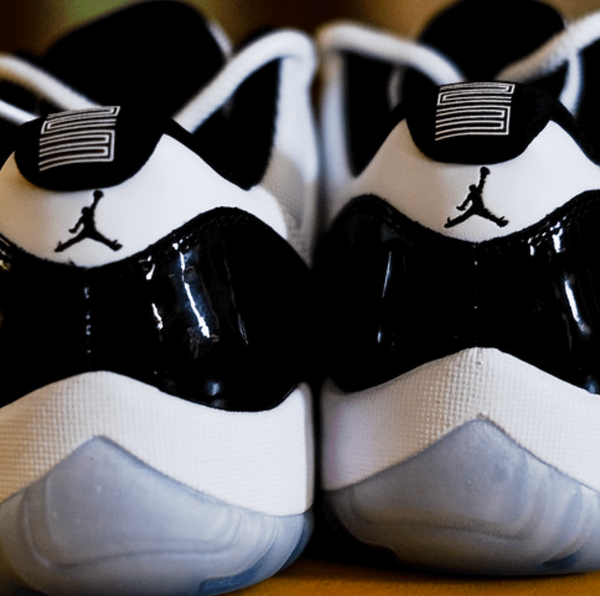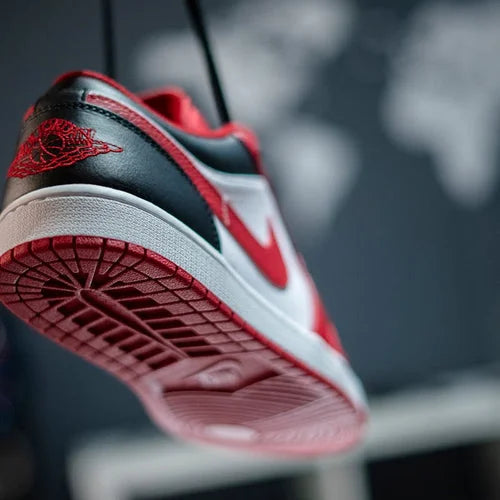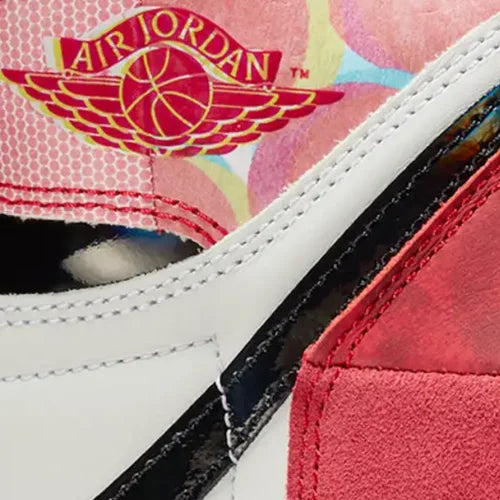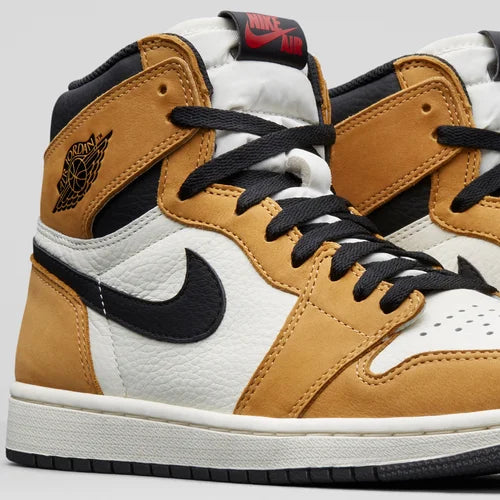How To Spot Fake Jordan 1 Retro High University Blue

Comfortable, stylish, sleek… and much more. All these words can describe a single pair of shoes, the Jordan 1 Retro High University Blue Blacks. Sneaker collectors, fashionistas, and simple Nike fans buy hundreds of these every day.
However, in the huge amount of Jordans out there, you can find tens of replicas. Some are better, some are worse. But the main criterion here is the fact that they are counterfeit!
In today’s article, we’ll give you the instruments to spot a fake pair of Jordan 1 Retro High University Blue Blacks.
Table of Contents
[ open ]The Left Swoosh
The Swoosh is key when authenticating Jordan 1 University Blue. But it's not only about the Swoosh—it also involves the elements around it, like the shape of the heel. Let's start with that.
From a side view, the heel should be pretty straight or have a gentle curve. The fake pair tends to have a highly curved heel, especially at the bottom. Counterfeit Jordan 1s often look bulkier and more puffed up, missing the sleekness of the real ones.
Now, let's delve into the shape of the Swoosh itself. The best way to confirm its authenticity is by comparing it with a genuine pair. What matters most is ensuring the Swoosh isn't too high or too low. You can check its correct placement by observing the gap between the tip and the shoelace holes.

The Right Swoosh
Let's examine the main parts of the Swoosh: the stem, curve, and tip. The stem should be thin, unlike the replica's thicker version. The curve might be tricky to replicate, but it shouldn't stand out too much or be too subtle. Regarding the tip, it should be clear, sharp, and pointed. Also, the Swoosh's length should be just right—not too short or too long.
In many fake pairs, the stitching is off. Common mistakes involve stitch size, color, length, and thread density. We'll discuss this further soon. Pay particular attention to the corner stitch next to the Swoosh. Make sure it doesn't cross the Swoosh at the corner.

The Air Jordan Logo
One notable flaw in replica Jordan 1 University Blue pairs relates to the spacing between the logo's elements. The real logo displays narrower gaps (such as those between the wings), resulting in a sleeker look.
Regarding the stitching, you can apply the same methods we've previously discussed for authentication. The key is ensuring that each stitch is consistently aligned.
Lastly, it's important to evaluate the fonts used in the logo. A helpful clue is the ™ sign. In genuine logos, the letters are wider with clearer lines.

The Heel
Let's shift our attention to a standout feature of Jordan 1's—the heel. You might be wondering what makes it so special. It's the "hourglass" shape: broader at the top and bottom and narrower in the middle.
This hourglass contour should be nearly flawless in all genuine pairs. This means the heel shouldn't be excessively bulky, show a gentle curve, and maintain its unique form. However, the fake shoes appear noticeably thicker, struggle to uphold the silhouette, and slant inward more.
Yet, it's not only the shape that merits examination. Now, let's verify the stitching. Every stitch should match in both size and shape. In contrast, imitation sneakers reveal noticeably untidy stitching, with numerous stitches shorter or longer than the standard length.
Also Read: How To Spot Fake Jordan 1 Off-White UNC

The Tongue Tag
First, take a closer look at the logo's font. Replicas often have a noticeable flaw: the Nike logo tends to have thicker and larger letters that slant more to the right.
Even the "AIR" letters are not quite right, as they appear more rounded and shorter than the original logo. Additionally, the shape of the Swoosh might be a little off.
Lastly, be sure to inspect the finer details, like the two ® signs flanking the Nike logo. Confirm that they are both clear and correctly positioned.

The Outsole
Let's delve into this eye-catching pair's distinctive feature: the vibrant blue outsole. The color truly enlivens the design, setting it apart and making color accuracy pivotal.
Now, note the outsole's centerpiece—a prominent Nike logo. Start by examining the logo's placement for any irregularities. Firstly, it should be perfectly centered on the outsole. Secondly, unlike the imitation version, it shouldn't be excessively tilted.
Progressing, examine the font for any deviations. The ® symbol must be clear, evident, and appropriately sized. Also, don't overlook the Swoosh. In fake versions, it appears slightly shorter and less curved.
The outsole showcases a pattern of small lines and other elements. While these might not catch the eye from a distance, their significance remains. Ensure these elements are crisp, well-defined, and don't merge or appear blurry.

The Size Tag
No matter the Jordan model, this corner consistently displays two printed letters. Interestingly, when comparing authentic and fake Air Jordan 1 Retro, these letters notably differ—the ones on counterfeit pairs often appear narrower and taller.
Regarding the other text on the size tag, the size table is of utmost importance. In this section, not only are the numbers more pronounced, but they might also appear less clear. Typically, in replica Jordan pairs, size tags are less readable, displaying tiny imperfections in the lettering.

Want to learn more? Explore more Jordan legit check guides from our library: Jordan 1 Chicago, Jordan 1 Dark Mocha.
The Footbed
When examining the footbed, take out the insole to see underneath.
One of the most noticeable differences between a fake and authentic Jordan University Blue is the stitching on the footbed. On the genuine footbed, the stitches are small and precise. They should be evenly spread around the edge of the footbed, with consistent size and thickness.
However, the fake pair deviates from this pattern. You can clearly see that almost every stitch varies in position and size. The threads also differ in how closely they're sewn, with short and thin stitches on the bottom right side and long and thick stitches on the upper left.
Lastly, focus on the material of the footbed, which resembles cardboard. In this case, the real one seems to have a more "grainy" texture than the fake version.

The Shoebox
Let's wrap up by discussing the shoebox.
The initial difference between a fake and a genuine is the box's shine. The real box reflects much light, while the replica has a duller finish and absorbs it. Furthermore, the colors on the real box appear more vivid, whereas those on the fake one look faded.
Next, pay attention to the noticeable Nike logo. Specifically, look closely at the fine lines that separate the letters of the logo. These lines should be thicker on the genuine box compared to the replica. Additionally, the fake box shows a slight tilt in these lines.
Lastly, take a look at the label that lists the various sizes. The font here is crucial. In the right photo, the letters are notably thinner, suggesting that the replica makers used the wrong font.
Also, notice that the "made in China" text beneath the size table is written in much smaller letters.

When did Air Jordan 1 Retro High University Blue release?
This model dropped on March 6th, 2021. Rocking one of the classic Jordan colorways, it hit retail for quite a modest price of $170 USD.
Where to buy Air Jordan Retro OG University Blue?
Originally, these sneakers were released on the Nike SNKRS app. If you were among the many unlucky ones who weren’t able to cop them, don’t worry! You can still get your hands on them on StockX, Grailed, and some selected retail websites.
Where can I get my Air Jordan 1 University Blue authenticated?
Looking for a high quality authentication for a fair price? Check out our legit check service! Our team of experts is always happy to assist you here: Jordan legit check.
















